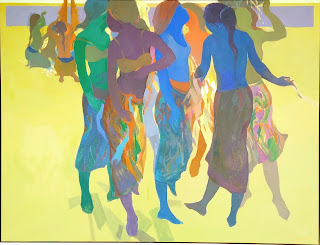Famous for his nude figures, or just its outlines, Khalil Ibrahim has sustained a long career as a full-time artist with his figurative paintings. In the retrospective at the relocated KL Lifestyle Art Space, it is indicative that Khalil’s artistic development has stagnated since the 1980s. Comparing two watercolour pictures of nude figures hung side by side – one from 1980 and the other from 2005 – the difference is not discernible, down to the disproportionate calves. For his current signature style, grey-brownish bodies evolve into primary colour forms, effectively diminishing the sensual elements. At its best, this abstraction denotes a loss of desire; at its worst, such pictures pander only to market pressures. Alas, the predicaments of a modern artist in Malaysia.
| Image may be NSFW. Clik here to view.  |
| Khalil Ibrahim – Pantai Bali (2005) |
Artists based in Kuala Lumpur and Manila exhibit works in “Tales of the City” at G13, assigned the theme to “explore the cultural complexities of urban condition in both countries”. Overlapping outlines and 3-D characters denote a crowded sphere, while oversized portraits and conflated symbols isolate singular objects from a perceived mass. Lovely paintings of shopfronts by Francis Commeyne preserve a vital sheen, which contrasts with the common approach of depicting aged stuff. In group shows with vague themes, works that has a specific reference point are the most potent. Gan Sze Hooi’s ‘Into the Jail’ see his cartoonish figures occupy a demolishedheritage site – with its butterfly plan, Moorish gate, and ironic murals intact – and giant figures of authority looming over the commoner. This is not an image from the past, but an accurate capture of the present.
| Image may be NSFW. Clik here to view.  |
| Paintings in Gan Sze Hooi's studio, for the "Tales of the City" art exhibition [picture from Gan Sze Hooi's web log] |
Leave it to Tan Zi Hao to use Malaysian vocabulary to literally describe farting sounds, backlit for those who cannot read clearly the words displayed at squatting height. Together with Leo So, “OFFART” shows works encumbered with deep frustration at the local socio-political sphere, a week after hundred thousands of annoyed urbanites gathered at the heart of Kuala Lumpur. The alphabet ‘t’ as Christian cross, book passages, and an iconic gesture, are symbols manipulated by Zi Hao in his cynically biting expressions. Toilet humour is more overt in Leo’s creations, which neon green paint and illustrated flies cover his canvases. This event works wells to entertain visitors still holding onto post-Bersih emotions. Entering the exhibition space, one is greeted by a stenciled idiom about farting, and a large fly perched upon a blacked out politician’s head. Such SHIT have to elicit a smile.
| Image may be NSFW. Clik here to view.  |
| [l] Leo So - Najis (2015); [r] Tan Zi Hao - Malaysian Politics 101 (2015) |
Without proclamations of greatness, Art Expo Malaysia Plus 2015 was a subdued affair, which make for a pleasant walkabout. Group selfies were popular at booths showing eye-catching pictures, while Xin Art Space presented a wall of Pangrok Sulap prints, its sales proceeds going to the Ranau earthquake aid efforts. Hard-edged Japanese and Korean works do well to strike a balance, for viewers tired of surreal juxtapositions and all-over abstractions that characterise the majority of offerings at the fair. Great Malaysian works spotted include Seah Zelin at Taksu, whose “Vase of Flowers” are beautiful and contemporary renditions of a still-life subject matter. At Segaris, Tengku Sabri Tengku Ibrahim’s wooden creation preserves his personal style yet demonstrates an innovative streak, which immediately shows up the booth’s other showpieces as boring rehashes.
| Image may be NSFW. Clik here to view.  |
| Installation snapshot of Tengku Sabri Tengku Ibrahim - Fragment #1: Broken Landscape (2015) |
A collective made up of Shooshie Sulaiman, Anwar Suhaimi, and Izat Arif, occupy a Damansara Heights bungalow lot, turning it into a gallery space and al-fresco café. Its first show, “Otak Jepun”, presents Yutaka Inagawa and his surreal collages that are framed, tacked to the wall, and even folded into ventilation openings. The exhibition statement relates about a Japanese “visual and design language”, but nonsensical cut-outs stuck onto a white background are always a delightful sight, especially when metaphorical associations are ignored altogether. The choice of subjects and picture planes created become the main focus, and rewards the tired visitor with refreshing images. A giant duck placed upon a baby stroller waiting to fly, anyone?
| Image may be NSFW. Clik here to view.  |
| Installation snapshot of "Otak Jepun" at Lorong Kekabu |